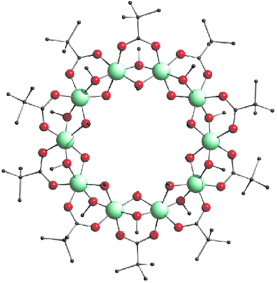Abstract of Publication No. 539
 David M. Low, Gopalan Rajaraman, Madeleine Helliwell, Grigore Timco, Joris van Slageren, Roberta Sessoli,
Stefan T. Ochsenbein, Roland Bircher, Christopher Dobe, Oliver Waldmann, Hans-Ulrich Güdel,
Mark A. Adams, Eliseo Ruiz, Santiago Alvarez and Eric J. L. McInnes
David M. Low, Gopalan Rajaraman, Madeleine Helliwell, Grigore Timco, Joris van Slageren, Roberta Sessoli,
Stefan T. Ochsenbein, Roland Bircher, Christopher Dobe, Oliver Waldmann, Hans-Ulrich Güdel,
Mark A. Adams, Eliseo Ruiz, Santiago Alvarez and Eric J. L. McInnes
A Family of Ferro- and Antiferromagnetically Coupled Decametallic Chromium(III) Wheels
Chem. Eur. J. 12, 1385-1396 (2006)
![]()
![]()
Abstract:
The synthesis and crystal structures of a family of decametallic
CrIII "molecular wheels" are reported, namely
[Cr10(OR)20(O2CR’)10]
[R’=Me, R=Me (1), Et (2);
R’=Et, R=Me (3), Et
(4); R’=CMe3, R=Me
(5), Et (6)]. Magnetic studies on 1-6 reveal a
remarkable dependence of the magnetic behaviour on the nature of R. In each pair
of complexes with a common carboxylate (R’) the nearest neighbour
Cr···Cr magnetic exchange coupling is more
antiferromagnetic for the ethoxide-bridged (R=Et) cluster than for the methoxide
analogue. In complexes 2, 4 and 6 the overall coupling is
weakly antiferromagnetic resulting in diamagnetic (S=0) ground states for
the cluster, whilst in 1 and 5 it is weakly ferromagnetic thus
resulting in very high-spin ground states. This ground state has been probed
directly in the perdeuterated version of 1 ([D]1) by inelastic
neutron scattering experiments, and these support the S=15 ground state
expected for ferromagnetic coupling of ten CrIII ions, and they also
indicate that a single J-value model is inadequate. The ground state of
5 is large but not well defined. The trends in J on changing R are
further supported by density functional calculations on 1-6, which
are in excellent agreement with experiment. The very large changes in the nature
of the ground state between 1 and 2, and 5 and 6 are
the result of relatively small changes in J that happen to cross
J=0, hence changing the sign of J.